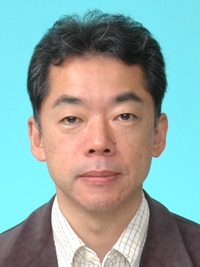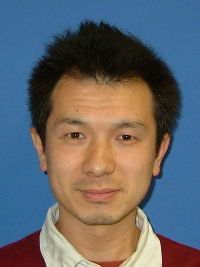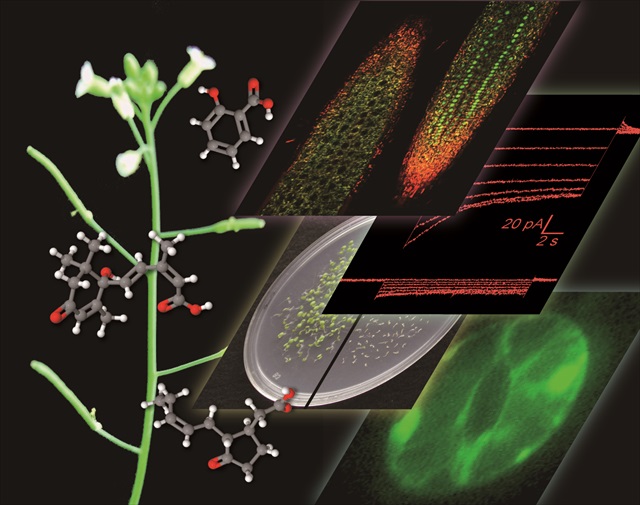
Research
Group of Environmental Response Systems
 |
Link to group homepage |
Faculty staff
 |
Prof. Dr. Takashi HIRAYAMA E-mail: hira-tATokayama-u.ac.jp |
(please change AT to @ before sending) | ||
 |
Assoc. Prof. Dr. Izumi MORI E-mail:imoriATokayama-u.ac.jp |
(please change AT to @ before sending) | ||
 |
Assoc. Prof. Dr. Yoko IKEDA E-mail:yikedaATokayama-u.ac.jp |
(please change AT to @ before sending) |
Lectures: Environmental Stress Response Systems, Advanced Signaling Mechanisms, Plant Molecular Cell Physiology
Keywords: Environment; Stress response; Phytohormones; Signal transduction
Summary of main research topics
| Uncovering secrets of plants: how plants ‘know’ their surroundings and ‘think up’ ways to cope with them Being sessile, plants must adapt to all environmental changes or perish. Plants are already well-known to recognize environmental fluctuations and to respond promptly to such changes. Nevertheless, it remains unclear how plants dissect and integrate environmental signals and make a decision to render an optimal response even with no information-integration systems such as those of our central nervous system. To address this question, our group investigates environmental stress response systems of plants using physiological, molecular biological, and molecular genetic approaches. Among stress responses, we emphasize the study of stress-associated plant hormone signaling. Our ultimate goal is to take advantage of the research outcomes to create stress-tolerant crops. |
 |
Latest publications (for complete and most current publications visit group pages)
(1) Hirano, T., Okamoto, A., Oda, Y., Sakamoto, T., Takeda, S., Matsuura, T., Ikeda, Y., Higaki, T., Kimura, S., Sato, M. H. Ab-GALFA, A bioassay for insect gall formation using the model plant Arabidopsis thaliana. Sci. Rep. 13: 2554. doi.org/10.1038/s41598-023-29302-8 (2023. 2.)
(2) Kim. J. S., Takahagi, K, Inoue, K., Shimizu, M., Uehara-Yamaguchi, Y., Kanatani, A., Saisho, D., Nishii, R., Lipka, A. E., Hirayama, T., Sato, K., Mochida, K. Exome-wide variation in a diverse barley panel reveals genetic associations with ten agronomic traits in Eastern landraces. Journal of Genetics and Genomics 50: 241-252. doi.org/10.1016/j.jgg.2022.12.001 (2023. 4.)
(3) Mori, I. C., Matsuura, T., Otao, M., Ooi, L., Nishimura Y., Hirayama, T. Application of trehalose mitigates short-styled flowers in Solanaceous crops. J. Agric. Food Chem. 71: 5476-5482. doi.org/10.1021/acs.jafc.2c08479 (2023. 4.)
(4) Himi, E., Matsuura, T., Miura, H., Yoshihara, N., Maekawa, M. A new method for detecting proanthocyanidin content in wheat reveals the relationship between R-1 gene to grain color deepness. Cereal Chemistry 100: 512-521. doi.org/10.1002/cche.10629 (2023. 4.)
(5) Ishii, C., Nagano, M., Kobayashi, M., Matsuura, T., Konishi, J., Aoki, K., Daimon, H., Mori, I. C., Fukao, Y. Wood vinegar promotes rice growth by increasing gibberellin and cytokinin levels. The Japan Carbonization Research Society 1: 41-50. (2023. 4.)
(6) Kimura, S., Vaattovaara, A., Ohshita, T., Yokoyama, K., Yoshida, K., Hui, Agnes, Kaya, H., Ozawa, A., Kobayashi, M., Mori, I. C., Ogata, Y., Ishino, Y., Sugano, S. S., Nagano, M., Fukao, Y. Zinc deficiency-induced defensin-like proteins are involed in the inhibition of root growth in Arabidopsis. Plant J. 115: 1071-1083. doi.org/10.1111/tpj.16281 (2023. 8.)
(7) Zhao, M., Nakamura, T., Nakamura, Y., Munemasa, S., Mori, I. C., Murata, Y. The effect of exogenous dihydroxyacetone and methylglyoxal on growth, anthocyanin accumulation, and the glyoxalase system in Arabidopsis. Biosci. Biotechnol. Biochem. 87: 1323-1331. doi.org/10.1093/bbb/zbad109 (2023. 8.)
(8) Ushio, M., Ishikawa, T., Matsuura, T., Mori, I. C., Kawai-Yamada, M., Fukao, Y., Nagano, M. MHP1 and MHL generate odd-chain fatty acids from 2-hydroxy fatty acids in sphingolipids and are related to immunity in Arabidopsis thaliana. Plant Sci. 336: 111840. doi.org/10.1016/j.plantsci.2023.111840 (2023. 11.)
(9) Ichiyanagi, K., Ikeda, Y., Saito, K. The sixth Japanese meeting on biological function and evolution through interactions between hosts and transposable elements. Mob. DNA. 14: 22. doi.org/10.1186/s13100-023-00310-9 (2023. 12.)





